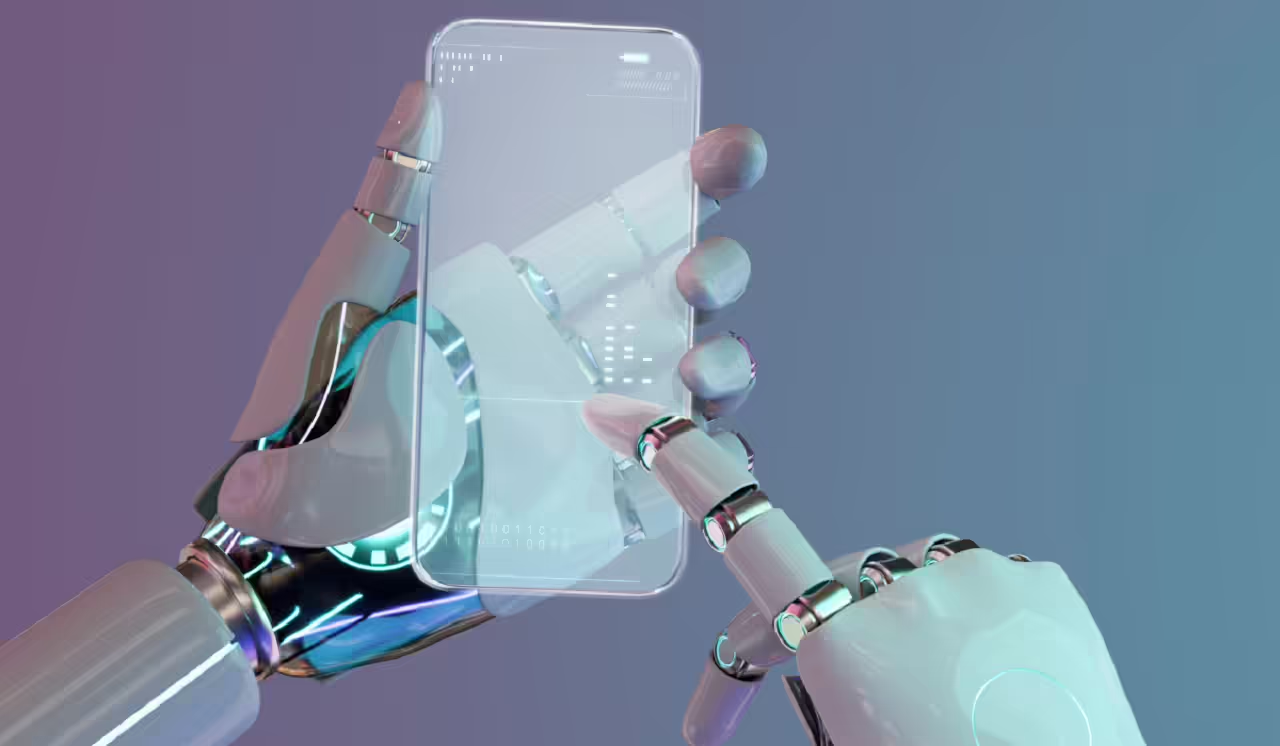
Intelligent Virtual Assistants: The AI-Driven Evolution
In the past decade, virtual assistants have evolved from being mere technological curiosities to becoming indispensable tools in our daily lives. Names like Siri, Google Assistant, and Alexa have entered the everyday vocabulary of millions of people, thanks to their ability to perform tasks, answer questions, and help manage our routines. But what’s behind this evolution? The answer is artificial intelligence (AI).
The Beginning of a Digital Revolution
When Siri was first launched in 2011, it offered a glimpse of the future: an assistant that could answer basic questions, set reminders, and conduct internet searches. While impressive at the time, Siri had limitations, and its understanding of natural language was basic. Since then, advances in artificial intelligence have allowed these assistants to learn, adapt, and offer more precise and useful responses.
Natural Language Understanding
One of the most significant advancements has been the improvement in natural language understanding. Thanks to AI, virtual assistants can now understand and process human language much more fluidly and naturally. There’s no longer a need to phrase questions rigidly or simplistically; these assistants can understand context, idioms, and even tone of voice.
Google Assistant, for instance, uses advanced natural language processing (NLP) models to understand not only what you say but also what you mean. This allows for more natural and conversational interaction, making users feel as if they are talking to a person rather than a machine.
Machine Learning and Personalization
Another key aspect of the evolution of virtual assistants is their ability to learn and adapt over time. By using machine learning techniques, assistants like Alexa can recognize patterns in user behavior and personalize their responses and suggestions based on these observations.
For example, if you regularly ask Alexa for the news in the morning, over time, the assistant will start suggesting relevant news without being asked. Similarly, Google Assistant can learn your daily routes and offer traffic information or remind you of important events before you even ask.
Integration with Smart Homes
Artificial intelligence has also enabled these assistants to integrate more deeply with other devices and services in the home. Today, it’s common for virtual assistants to control lights, thermostats, security cameras, and more, creating a smart home ecosystem that responds to your voice commands.
Siri, for example, with its integration into the Apple ecosystem, allows control of devices through the HomeKit app, while Alexa and Google Assistant offer compatibility with a wide range of devices from different brands. This turns the virtual assistant into the control center of your home, simplifying everyday tasks and improving efficiency.
The Future of Virtual Assistants
Looking ahead, it’s clear that the evolution of virtual assistants is far from over. With the continuous development of artificial intelligence, we can expect these assistants to become even smarter, more intuitive, and more useful. Integration with emerging technologies such as augmented reality (AR) and virtual reality (VR) could open up new possibilities for interacting with our devices and environments.
Additionally, advances in emotional AI could allow virtual assistants to interpret and respond to human emotions, making interactions even more personalized and empathetic.
Voice Recognition and Natural Language: How Phones Understand and Process Your Commands with Greater Precision
Voice recognition and natural language technology have made tremendous strides in recent years, turning our phones into increasingly intuitive and accurate assistants. This capability, driven by artificial intelligence (AI), allows devices to understand voice commands, interpret context, and respond effectively, facilitating interaction between the user and technology.
The Evolution of Voice Recognition
Voice recognition on phones has evolved from a rudimentary function to an advanced tool that can interpret words, phrases, and even tone of voice with surprising accuracy. Initially, voice recognition systems required users to speak slowly and clearly, and even then, the results were often inaccurate. However, with advances in AI and machine learning, phones can now understand and process commands in real time, even in noisy environments or with diverse accents.
Apple’s Siri, Google Assistant, and Amazon’s Alexa are examples of how these advancements have improved the user experience. These virtual assistants not only recognize individual words but also understand context, allowing for more complex and natural tasks.
Natural Language Processing (NLP)
Natural Language Processing (NLP) is a branch of AI that focuses on the interaction between computers and human language. Thanks to NLP, phones can analyze and understand the meaning behind words rather than simply recognizing sounds. This allows devices to interpret more complex commands and respond appropriately.
For example, if you ask your voice assistant, “What’s the weather like today?” or “Do I need an umbrella?”, both commands, though phrased differently, will be understood as a request for weather information. Natural language processing allows the system to interpret the intent behind the question, giving you an accurate response no matter how you phrase it.
Machine Learning for Greater Precision
Machine learning plays a crucial role in improving voice recognition and natural language processing. As users interact with their devices, these systems collect data and learn from it. This continuous learning allows phones to improve their ability to recognize patterns, adjust their understanding, and offer more precise responses over time.
For example, Google Assistant uses deep learning models to improve its ability to understand and respond to voice commands. The more you use it, the more personalized it becomes, learning your preferences, speech patterns, and accent. This translates to a smoother and more efficient experience, where the virtual assistant can anticipate your needs and offer suggestions before you even ask.
Practical Applications of Voice Recognition
Voice recognition and natural language processing have numerous practical applications on phones. From setting reminders and alarms to searching the internet and drafting messages, these features are designed to make life easier.
Moreover, accessibility applications have significantly improved thanks to these technologies. People with visual or motor disabilities can interact with their devices using just their voice, providing them with greater autonomy.
Another area where voice recognition is making a difference is in real-time translation. Applications like Google Translate use these technologies to instantly convert speech from one language to another, facilitating communication in situations where language might otherwise be a barrier.
Challenges and the Future of Voice Recognition
Although voice recognition and natural language processing have advanced, they still face challenges. Variations in accents, dialects, and background noise can affect accuracy. However, developers continue to refine these systems to overcome these limitations.
In the future, we can expect these technologies to become even more precise and adaptable, allowing for more natural and fluid interactions with our devices. The integration of emotional AI could enable virtual assistants to not only understand what we say but also how we feel when we say it, adjusting their responses accordingly.
AI-Enhanced Photography: Revolutionizing Mobile Photography
The evolution of mobile photography has been impressive over the past decade, and much of this progress is due to the integration of artificial intelligence (AI) into phone cameras. What once required advanced photographic skills and expensive equipment is now within the reach of any user, thanks to AI-driven innovations. From portrait mode to automatic adjustment and scene recognition, artificial intelligence has transformed the way we capture and share images.
Portrait Mode: Capturing Beauty with Precision
One of the most notable features that AI has brought to mobile photography is portrait mode. This feature allows users to take photos with selective focus, where the main subject appears sharp while the background is blurred into an elegant bokeh effect. Previously, this type of image could only be achieved with digital single-lens reflex (DSLR) cameras and specific lenses. However, AI advancements have made it possible for phones to replicate this effect with surprising accuracy.
Portrait mode works by analyzing the image in real-time, identifying the main subject, and separating it from the background. AI not only detects the subject’s edges but can also apply automatic corrections to ensure that the background blur looks natural. Some phones, like the Google Pixel series and iPhones, even allow users to adjust the intensity of the bokeh after taking the photo, offering a level of control that was previously unimaginable in mobile devices.
Automatic Adjustment: Perfect Photography in Any Situation
Automatic adjustment is another feature where artificial intelligence has made a significant difference. Previously, taking a good photograph required the user to manually adjust parameters like exposure, white balance, and focus. Now, thanks to AI, phones can analyze the scene in real-time and make these adjustments automatically, ensuring that the photo turns out perfect in any condition.
AI in mobile cameras can recognize a wide variety of scenes and adjust the camera settings to optimize the image. For example, if you’re taking a photo at sunset, AI will adjust the exposure to capture the warm colors of the sky without overexposing the sun. At night, the camera can automatically activate night mode, which combines multiple exposures to create a clear and detailed image even in low-light conditions.
Scene Recognition: Understanding What You’re Capturing
Scene recognition is another powerful tool that AI has brought to mobile photography. This feature allows the camera to identify the type of scene you’re photographing, such as landscapes, food, portraits, animals, or buildings, and automatically adjust the settings to get the best possible result.
For example, when photographing food, AI can increase color saturation to make dishes look more appetizing. If you’re capturing a landscape, AI can intensify greens and blues to highlight nature. This ability of the camera to understand the context of the image and optimize the settings is what sets modern mobile photography apart from previous generations.
AI-Enhanced HDR Photography
High Dynamic Range (HDR) photography has been significantly improved with the help of AI. HDR combines multiple images taken with different exposures to create a single photo with a broader luminance range, allowing both bright and dark areas of the image to retain detail. With AI, phones can perform this operation more efficiently and quickly, resulting in HDR images that look more natural and less processed.
AI-Assisted Photo Editors
In addition to enhancing photo capture, artificial intelligence is also revolutionizing image editing. AI-assisted photo editors, such as Google Photos or Adobe Lightroom, can suggest automatic edits that improve image quality with a single tap. This includes adjustments to lighting, contrast, color, and even removing unwanted elements from the photo.
Some AI photo editors can even analyze the content of an image and suggest specific improvements based on what they detect. For example, if the AI identifies that the photo is of a landscape, it might suggest increasing saturation to make the colors pop. This simplifies the editing process and allows users to achieve professional-quality results without needing advanced editing skills.
The Future of AI in Mobile Photography
As AI continues to advance, we can expect even more innovative features in mobile photography. AI might eventually be able to predict the type of photo you want to take before you even press the shutter, automatically adjusting settings and offering suggestions in real-time.
We may also see AI integrate more deeply with augmented reality (AR), allowing users to overlay virtual elements in their photos in a way that looks natural and convincing. This could open up new creative possibilities and change the way we interact with photography.
Security: How Artificial Intelligence Protects Your Information
In an increasingly digital world, security has become a priority for smartphone users. Fortunately, artificial intelligence (AI) is playing a critical role in protecting our personal information, ensuring that our devices and data are secure from threats. AI is revolutionizing the way we approach security on mobile devices, from biometric authentication to detecting and preventing cyberattacks.
Biometric Authentication: Your Unique Signature
Biometric authentication is one of the most visible ways AI is improving security on smartphones. Techniques like fingerprint recognition, facial recognition, and voice recognition have become the standard for unlocking devices and authorizing transactions. These methods rely on AI to analyze and verify the user’s unique characteristics, making it much harder for unauthorized individuals to gain access.
For example, facial recognition technology, used in phones like the iPhone and certain Android models, uses AI to create a detailed map of the user’s face. This map is then compared to the person’s face each time they try to unlock the device. If there’s a match, the phone unlocks. The AI algorithms behind this technology are designed to detect even the slightest differences, ensuring that only the authorized user can unlock the device.
Malware Detection and Prevention
AI is also essential in detecting and preventing malware and other cyber threats. Traditional security methods relied on a database of known threats, which meant that new or unknown threats could slip through the cracks. AI changes the game by using machine learning algorithms to detect unusual patterns of behavior that could indicate a potential threat, even if the specific malware hasn’t been identified before.
For example, if an app starts behaving in a way that’s different from its usual pattern, such as accessing sensitive data without permission or connecting to suspicious servers, AI can flag it as potentially dangerous and take action, such as notifying the user or automatically blocking the app. This proactive approach significantly reduces the risk of cyberattacks and keeps your data safe.
AI-Driven Encryption
Encryption is a fundamental tool for protecting data, and AI is making it more robust and efficient. AI can optimize encryption algorithms, making them faster and more resistant to attacks. Additionally, AI can help in developing new encryption techniques that are harder to crack, ensuring that your personal information remains confidential.
AI can also be used to manage encryption keys more effectively, ensuring that they are stored securely and that unauthorized access is prevented. This adds an extra layer of protection, making it much more difficult for attackers to gain access to encrypted data.
Spam and Phishing Detection
Spam and phishing attacks are common methods that cybercriminals use to steal personal information. These attacks often come in the form of emails, text messages, or even phone calls that appear to be legitimate but are designed to trick the user into revealing sensitive information.
AI is instrumental in detecting and blocking these types of attacks. By analyzing patterns and comparing them to known phishing tactics, AI can identify suspicious messages and warn users before they fall into the trap. For example, if a message contains a link that leads to a site known for phishing, AI can automatically block the message or notify the user of the potential danger.
Privacy: Keeping Your Personal Information Safe
In addition to security, AI is also helping to protect user privacy. With growing concerns about data collection and surveillance, AI tools are being developed to give users more control over their personal information.
For example, AI can be used to manage permissions on your phone, ensuring that apps only have access to the data they need to function. If an app requests unnecessary permissions, AI can notify the user and offer the option to block or limit access.
AI is also being used to develop tools that can anonymize data, making it more difficult for companies or third parties to track users’ activities online. This helps protect user privacy and reduces the risk of data being misused or sold to third parties without consent.
The Future of AI in Security
As threats continue to evolve, AI will play an even more crucial role in protecting our devices and personal information. Future developments could include AI systems that can anticipate threats before they even occur, using predictive algorithms to identify and neutralize potential dangers.
Additionally, AI could be used to develop more sophisticated authentication methods that go beyond biometrics, such as behavioral recognition, which analyzes the user’s behavior patterns to confirm their identity.
Battery Management: AI Keeps Your Phone Running Longer
One of the most common complaints among smartphone users is battery life. As phones become more powerful and feature-rich, managing energy consumption has become a priority. Artificial intelligence (AI) is playing a key role in improving battery life by optimizing how power is used, predicting energy needs, and adapting to user habits.
Smart Power Management
AI is used to manage the phone’s power consumption intelligently. This includes analyzing which apps and functions are consuming the most energy and making adjustments to extend battery life. For example, if AI detects that a particular app is using a lot of energy in the background, it can limit its activity or suggest that the user close it to conserve power.
Some phones use AI to manage power distribution among the different components of the device, such as the processor, screen, and sensors. By distributing energy more efficiently, AI can extend battery life without sacrificing performance.
Adaptive Battery
Adaptive battery is a feature that uses AI to predict how the user is likely to use their phone and optimize battery usage accordingly. For example, if the AI knows that you typically use a particular app at a certain time of day, it will allocate power to that app in advance, ensuring smooth performance when you need it. Conversely, if an app is rarely used, the AI will limit its power consumption.
This type of intelligent power management allows the phone to adapt to the user’s habits, providing better battery life based on individual usage patterns.
Battery Health and Longevity
AI also plays a role in maintaining battery health and extending its overall lifespan. Batteries degrade over time, but AI can help slow this process by optimizing charging cycles and reducing the stress on the battery. For example, some phones use AI to manage charging speed, slowing it down when the battery is near full capacity to reduce wear and tear.
AI can also monitor battery health and provide insights to the user, such as warning when it’s time to replace the battery or offering tips on how to prolong its life. This proactive approach ensures that the battery remains in good condition for as long as possible.
Energy-Saving Modes
Many smartphones come with energy-saving modes that are enhanced by AI. These modes automatically adjust settings like screen brightness, refresh rate, and background activity to conserve power when the battery is low. AI can optimize these modes based on the user’s habits and the specific conditions of the device, providing the best balance between performance and battery life.
For example, if AI detects that you’re about to run out of battery while traveling, it might automatically reduce screen brightness, turn off unnecessary notifications, and limit background activity to ensure the battery lasts until you can recharge.
Predictive Charging
Predictive charging is a feature that uses AI to optimize charging times based on your daily routine. For example, if you usually charge your phone overnight, AI can slow down the charging process to ensure that the battery reaches full capacity just before you wake up. This reduces the amount of time the battery spends at 100% charge, which can help prolong its lifespan.
AI can also predict when you’ll need a full battery and adjust the charging speed accordingly. For example, if AI knows that you have a busy day ahead, it might charge the phone more quickly in the morning to ensure you have enough power to get through the day.
The Future of AI in Battery Management
As AI continues to advance, we can expect even more sophisticated battery management features in the future. This could include AI systems that can predict energy needs more accurately, optimize power distribution across multiple devices, and even manage wireless charging networks.
In the future, AI could also play a role in developing new battery technologies, such as solid-state batteries or energy-harvesting systems, which could revolutionize how we think about battery life and energy consumption on mobile devices.
AI-Enhanced Communication: How AI is Changing the Way We Connect
Artificial intelligence (AI) is transforming the way we communicate through our smartphones, making interactions more intuitive, efficient, and personalized. From real-time language translation to predictive text and smart replies, AI is enhancing our communication experience, breaking down language barriers, and making it easier to stay connected.
Real-Time Language Translation
One of the most impressive applications of AI in communication is real-time language translation. Apps like Google Translate and Microsoft Translator use AI to instantly translate spoken or written text from one language to another, allowing people who speak different languages to communicate effortlessly.
AI-driven translation algorithms have become increasingly accurate, thanks to advances in machine learning and natural language processing. These technologies allow the app to understand context, idiomatic expressions, and cultural nuances, resulting in translations that are not only accurate but also natural-sounding.
Real-time translation is particularly useful for travelers, business professionals, and anyone who needs to communicate across language barriers. With AI, your smartphone becomes a powerful tool for connecting with people from around the world, regardless of the language they speak.
Predictive Text and Smart Replies
Predictive text and smart replies are AI-driven features that make typing on your smartphone faster and more efficient. Predictive text suggests words or phrases as you type, based on what it predicts you’re going to say next. Smart replies take this a step further by suggesting entire responses based on the context of the conversation.
For example, if someone sends you a message asking if you’re available for a meeting at 3 PM, your phone might suggest responses like “Yes, that works,” “Sorry, I’m busy,” or “Can we do 4 PM instead?” These suggestions save time and make it easier to respond quickly, especially when you’re on the go.
AI powers these features by analyzing your past conversations and learning your writing style, preferences, and common phrases. The more you use them, the more accurate and personalized the suggestions become.
Voice Assistants
Voice assistants like Siri, Google Assistant, and Alexa are some of the most popular AI-driven communication tools on smartphones. These assistants allow you to interact with your device using natural language, making it easier to perform tasks, get information, and stay connected.
AI enables voice assistants to understand and process complex commands, such as setting reminders, sending messages, or playing music. They can also handle more advanced tasks, like making restaurant reservations or controlling smart home devices, all through simple voice commands.
As AI continues to improve, voice assistants are becoming more conversational and capable of handling multi-step tasks, making them even more useful for communication and daily life.
Emotion Recognition and Sentiment Analysis
AI is also being used to analyze the emotional tone of written and spoken communication. This technology, known as sentiment analysis, can detect whether a message is positive, negative, or neutral, helping to better understand the sender’s intent.
For example, customer service chatbots often use sentiment analysis to gauge the customer’s mood and adjust their responses accordingly. If the AI detects that the customer is frustrated, it might prioritize resolving the issue quickly and offer a more empathetic response.
In the future, we may see sentiment analysis integrated into personal communication apps, providing insights into the tone of your conversations and helping you navigate complex social interactions.
Personalized Communication
AI is making communication more personalized by analyzing your behavior and preferences to deliver customized experiences. This includes everything from tailoring news feeds to suggesting contacts to reach out to based on your interactions.
For example, AI might notice that you frequently text a particular friend in the morning and suggest sending them a message when you first unlock your phone. Or it might analyze your communication patterns to help you manage your contacts more effectively, prioritizing those who matter most to you.
This level of personalization enhances the communication experience, making it easier to stay connected with the people and information that are most important to you.
The Future of AI in Communication
As AI continues to evolve, we can expect even more transformative changes in the way we communicate. Future developments could include AI-driven systems that can understand and adapt to individual communication styles, offering more nuanced and context-aware responses.
We may also see AI integrated into virtual and augmented reality environments, allowing for more immersive and interactive communication experiences. Imagine having a conversation with a holographic version of a friend, complete with real-time translation and emotion recognition, all powered by AI.







